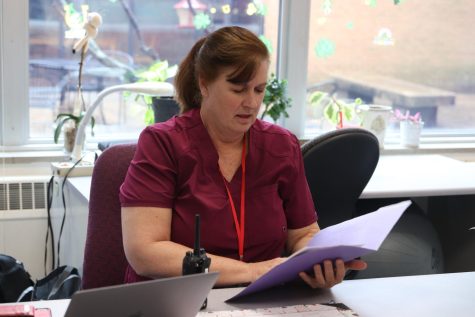Call Ed: Keep it old school
83% (54/65) of TKC staffers believe that four-day school weeks are too good to be true and should not be established.
Seventy-two hours of relaxation, 4,320 minutes of spending time with your friends and family, 259,200 seconds of catching up on some much-needed sleep — a three-day weekend would provide this luxury for students every school week. This four-day school-week model is becoming a reality for over 1,600 schools nationwide, according to a 2021 MIT Press Direct study, with numbers increasing each year. In regards to KSD, superintendent Dr. David Ulrich said that there is no intention of KSD moving to four-day school weeks. But while other schools nationwide are implementing this seemingly “beneficial” model, 83% (54/65) of TKC staffers believe that in reality, four-day school weeks are too good to be true and should not be established.
In order to attract and retain teachers, in addition to cutting costs, districts around the U.S. are moving toward the four-day school week model. More than a quarter of school districts established this at the start of the 2022-2023 school year in Missouri, according to USA Today, and most schools that turn to four-day weeks are small and in rural areas. To Kellie Brown, a Poplar Bluff, Missouri resident, the four-day school model wouldn’t work long term, and instead would severely affect the learning of children.
“I live in a very rural area,” Brown said. “I am a mother of five, three of which are younger, so they’re in elementary [school]. We don’t have good childcare here. I’ve been a single mom for a very long time, [and] I don’t believe that [schools] should go to four days because it’s hard enough for parents to work and pay their bills. It makes it even harder when you can’t find good childcare. And when you do find good childcare, you might as well just spend your whole check on it.”
While some four-day districts offer childcare on their day off, the cost for school-operated child care varies. The Independence School District has decided to implement the four-day model for the 2023-2024 school year, and will be the largest Missouri district to do so with 14,200 students. According to superintendent Dr. Dale Herl, the main reason for moving the district to four days is staff recruitment and retention, and the district will actually be spending more money by establishing this model. In offering childcare, Herl said the district is lowering their childcare cost to $30 a day. This is extra money parents have to pay weekly, and this significantly puts lower-income, working parents at a disadvantage. Low-income families also depend on public schools to provide meals for their kids, but with one day less of school a week, families now have to find a way to provide breakfast and lunch for their child that day. With the change, students from affluent families most likely wouldn’t have an issue with four days, but by installing this, schools are treating poorer families in the district unfairly.
The issue with affording childcare doesn’t affect older, teenage students, so the question arises as to what this age group would do on their one day off. According to a RAND Corporation study, most students in the four-day districts (80% of high school students) spent their day off at home. Brown, psych counselor for a behavioral mental health center, said this might cause an increase in substance use, violence and criminal activity because students would have extra time on their hands. To Jess Piper, executive director of Blue Missouri and former teacher, the extra day in the four-week model would ultimately not help kids get ahead in school, like many would believe.
Districts need to realize that giving kids a day off of school every week would do more harm than good.
Piper has noticed students working jobs instead of focusing on their schoolwork on their day off in districts with 4-day school weeks. Piper lives in rural Northwest Missouri, and called the area a childcare desert. Since schools in her location don’t offer additional childcare, she found high schoolers who aren’t working jobs on their day off are instead babysitting younger kids since parents can’t find childcare. Districts need to realize that giving kids a day off of school every week would do more harm than good. A day of learning school material is much more productive and beneficial for students than compared to working jobs, getting into trouble or simply lounging around at home.
Almost every KHS student has experienced sitting in a classroom, seven hours into the school day, with only a break for lunch. You keep staring at the clock, anxiously watching the minute hand tick by, dreaming of the bell finally ringing. Whether it be going to your after school activity, work or simply relaxing at home, all you want to do is get out of school. But if your school were to implement the four-day model, you would have to endure around 40 extra minutes each day. Each state has a required number of minutes every school has to be in session, Missouri’s being 1080, and with eliminating one day of school a week, all those lost minutes have to be made up somehow. Along with adding minutes, after-school activities would have to start and end later, leading to longer days. At that point, students would barely see the sunlight — students would leave and return home from school in the dark. Many would guess that the four-day model would aid in battling student burn-out, but in actuality, adding more time to the school day as well as having activities later, would have the opposite effect. Dan Langford, Nipher teacher, said the last block of the school day is already hectic and he can’t imagine adding more time. To him, students and teachers are already tapped out and adding minutes would be asking too much.
The whole point of school is to have a quality education and prepare students for the future. But by eliminating a day of school every week, the quality of learning could be damaged. A 2022 ScienceDirect study that looked at four-day school schedules in 12 states found that student test scores in math and language arts fell slightly at schools operating an average of 29.95 hours per week. The role of schools is to equip their students with the necessary skills to succeed, so with declining test scores, the nation needs to rethink the four-day model. No “long weekend” is worth the success of our future generation.
In order to help retain teachers and save money without implementing four-day school weeks, TKC believes that the only substantial solution would be for government officials to better fund schools.
TKC believes that the only substantial solution would be for government officials to better fund schools.
A 2020 The Century Foundation study revealed that the U.S. is underfunding its K-12 public schools by nearly $150 billion annually. This is unacceptable. In order for students to be successful, lawmakers need to prioritize allocating money towards public schools. With properly funded schools comes qualified teachers and high student achievement. The sensationalization of the “four-day school week” is merely a band-aid for the root issue at hand. Instead, we should be focusing on providing adequate funding for public schools, which, if solved, would ensure no school would be forced to move to four-day weeks. In reality, the four-day model is a prime example of non student-centered decision making. Districts may say that students are at the core of all decisions, but the trend of moving to four-day school weeks would negatively affect them, exhibiting that students are not in the forefront of administrators minds’ at all. So yes, a seventy-two hour weekend may seem ideal, but not everything is as advantageous as it may appear.
Your donation will support the student journalists of Kirkwood High School. Your contribution will allow us to purchase equipment and cover our annual website hosting costs.
This is the opinion of the entire Kirkwood Call staff.

















